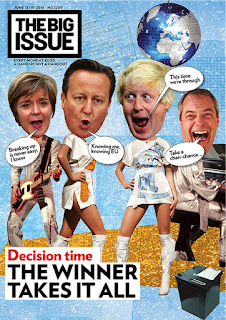Intertextual Analysis - The Big Issue

When first looking at the cover, what stands out the most is the use of humour to portray the 4 key politicians involved with the discussed topic of the issue: Brexit. The clear intertextual link seen across the cover is with the Swedish pop group, Abba. Both the images and the text clearly relate to the band; using this link creates a humiliating and foolish portrayal of these political leaders, as the cheesiness of the band shown around them is not their typical environment. The bodies that the politicians have been placed on are members of the band, an obvious intertextual link; the bands unique style isn’t a typical outfit to be seen on these members, emphasising the humour/humiliation around the politicians. The texts, represented as speech bubbles from the politician’s mouths, are lyrics from well-known Abba songs, knowing me, knowing you and take a chance on me. They are ironic to these politicians’ beliefs around the topic; this emphasises the link to the...